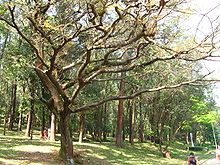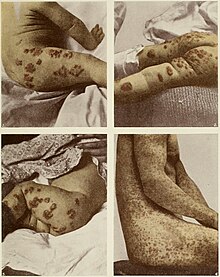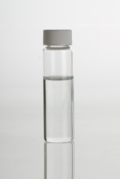Copaiba


Copaiba is an oleoresin obtained from the trunk of several pinnate-leaved South American leguminous trees (genus Copaifera). The thick, transparent exudate varies in color from light gold to dark brown, depending on the ratio of resin to essential oil. Copaiba is used in making varnishes and lacquers.
The balsam may be steam distilled to give copaiba oil, a colorless to light yellow liquid with the characteristic odor of the balsam and an aromatic, slightly bitter, pungent taste. The oil consists primarily of sesquiterpene hydrocarbons; its main component is β-caryophyllene.[1] The oil also contains significant amounts of α-bergamotene, α-copaene, and β-bisabolene.[2] It is also the primary source of copalic acid.[3]
Copaiba is also a common name for several species of trees of the legume family native to Tropical Africa and North and South America.
Uses
[edit]
Copaiba is particularly interesting as a source of biodiesel, because of the high yield of 12,000 L/ha (1,300 US gal/acre). The resin is tapped from standing trees, with an individual tree yielding 40 L (11 US gal) per year.[4][5]
Copaiba oil-resins extracted have been used in folk medicine dating back to the 16th century by the natives of north and northeastern Brazil. The folk remedies were administered orally or used as an ointment in the treatment of various diseases.[6] In Panama, the Yaviza people mix the resin with honey and give it to newborns to impart knowledge and ward off hexes.[7] Within the Peruvian Amazon near Iquitos, it is also used as an insect repellent.[8] The balsam and its oil are used as fixatives in soap perfumes and fragrances.[1]
Copaiba is also used as an artist material,[9] especially in oil paint recipes and in ceramic decoration. Mineral painters use a medium made of copaiba, turpentine and lavender to mix with their minerals for adhesion to ceramic vessels before kiln firing.[10] Copaiba makes a good medium for oils and helps with both adhesion and quality of shine.
Industry and commerce
[edit]The production of copaiba oil is socially significant to the Amazon because it represents approximately 95% of Brazil's oil-resin production industry. The Annual production of copaiba oil in the Amazon is estimated to be 500 tons/year.[11] The commercialization of copaiba as an oil or in capsule form has grown because of demand by traditional and widespread use, and is exported to other countries, including the United States, France, and Germany.[12]
The Food and Chemicals Codex lists copaiba oil as safe as a flavoring agent for foods.[13] Copaiba oil has both an acute oral and dermal LD50 exceeding 5 g/kg,[14] which classifies it as non-toxic.[15]
References
[edit]- ^ a b Karl-Georg Fahlbusch; et al. (2007), "Flavors and Fragrances", Ullmann's Encyclopedia of Industrial Chemistry (7th ed.), Wiley, p. 96
- ^ Valdir F. Veiga Jr. et al, Phytochemical and Antioedematogenic Studies of Commercial Copaiba Oils Available in Brazil; Phytotherapy Research, 15, 476-480 (2001).
- ^ Medeiros, Vanessa Gonçalves; Durán, Fernando Javier; Lang, Karen Luise (2021). "Copalic Acid: Occurrence, Chemistry, and Biological Activities". Revista Brasileira de Farmacognosia. 31 (4): 375–386. doi:10.1007/s43450-021-00173-2. S2CID 258704922.
- ^ "Farmer planning diesel tree biofuel". Sydney Morning Herald. 2006-09-19. Retrieved 2006-10-14.
- ^ "New fuel source from trees". Australian Broadcasting Corporation. 2007-04-24. Retrieved 2007-04-26. [dead link]
- ^ Almeida MR, Darin JD, Hernandes LC, de Souza Ramos MF, Antunes LM, de Freitas O (2012). "Genotoxicity assessment of Copaiba oil and its fractions in Swiss mice". Genet Mol Biol. 35 (3): 664–72. doi:10.1590/S1415-47572012005000052. PMC 3459418. PMID 23055807.
- ^ Duke, James A. (1982). "Copaifera langsdorfii Desf.". Handbook of Energy Crops. Purdue Center for New Crops.
- ^ Odonne, Guillaume (2014). "Ethnobotany of Amazonia". Encyclopaedia of the History of Science, Technology, and Medicine in Non-Western Cultures: 1–7. doi:10.1007/978-94-007-3934-5_9889-1.
- ^ van der Werf, Inez D.; van den Berg, Klaas Jan; Schmitt, Sibylle; Boon, Jaap J. (March 2000). "Molecular Characterization of Copaiba Balsam as Used in Painting Techniques and Restoration Procedures". Studies in Conservation. 45 (1): 1–18. doi:10.1179/sic.2000.45.1.1.
- ^ Haywood, Emma (January 1889). "Royal Worcester Decoration". The Decorator and Furnisher. 13 (4): 110-111.
- ^ Sustainability of extraction and production of copaiba (Copaifera multijuga Hayne) oleoresin in Manaus, AM, Brazil. (Medeiros and Vieira, 2008; Brazil, 2011). Medeiros RD, Vieira G. For Ecol Manage. 2008;256:282–288.
- ^ Veiga VF Jr, Zunino L, Calixto JB, Patitucci ML, Pinto AC (2001). "Phytochemical and antioedematogenic studies of commercial copaiba oils available in Brazil". Phytother Res. 15 (6): 476–80. doi:10.1002/ptr.976. PMID 11536374. S2CID 29960482.
- ^ Food and Chemicals Codex, Fourth Edition, 1996; National Academy Press, ISBN 0-309-05394-3
- ^ D. L. J. Opdyke, Food and Cosmetics Toxicology, Vol 14, p. 687 (1976)
- ^ Robert Tisserand, Tony Balacs (1995). Essential Oil Safety. Churchill Livingstone Press, ISBN 978-0443052606.

